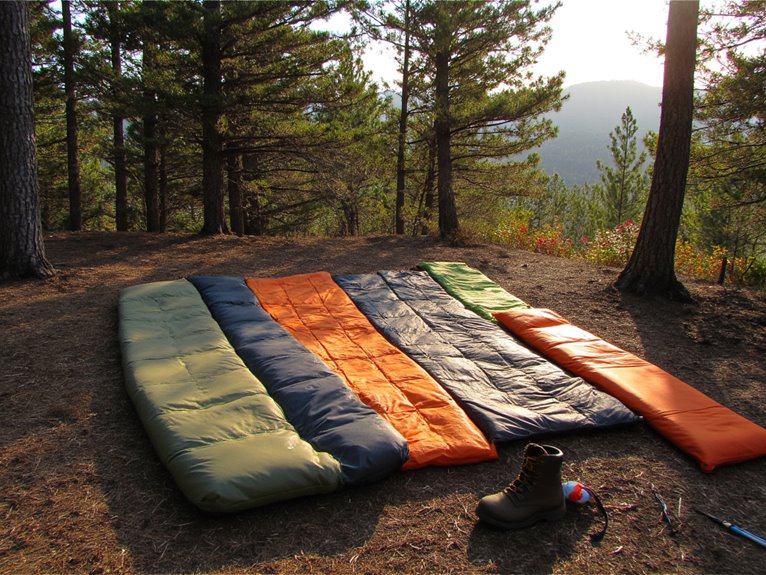Can a Yoga Mat Be Used as a Sleeping Pad?
A yoga mat can be used as a sleeping pad in a pinch, but its suitability depends on various factors. Thickness and material composition play a significant role in determining comfort and insulation. While a yoga mat may provide adequate comfort for back sleepers in warm weather, it may not be suitable for side sleepers or cold weather camping due to minimal thermal resistance. Material durability and construction also impact performance. To understand the practicality of using a yoga mat as a sleeping pad, consider the nuances of thickness, material, and intended use – and examine the specifics that can make or break a restful night's sleep.
We are supported by our audience. When you purchase through links on our site, we may earn an affiliate commission, at no extra cost for you. Learn more. Last update on 9th January 2026 / Images from Amazon Product Advertising API.
Thickness and Insulation Compared
Typically, outdoor enthusiasts prioritize a sleeping pad's thickness and insulation when selecting a comfortable and warm sleeping solution, and a yoga mat's capabilities in these areas warrant examination.
A standard yoga mat typically measures around 3-5 mm in thickness, which is substantially thinner than most sleeping pads. While this may not provide adequate comfort for side sleepers, back sleepers may find it sufficient.
With regard to insulation, yoga mats are designed for indoor use and provide minimal thermal resistance. They may not retain body heat well, making them unsuitable for cold weather camping.
However, for warm weather camping or indoor use, a yoga mat's thickness and insulation may be sufficient for a comfortable night's sleep.
Materials and Durability Matters
Embedded with a durable, non-slip surface, yoga mats are constructed from a variety of materials, including PVC, rubber, and polyurethane, which substantially impact their durability and overall performance as a sleeping pad.
These materials influence the mat's ability to withstand wear and tear, resist punctures, and maintain its shape over time.
For instance, PVC mats are often more prone to cracking, while rubber and polyurethane mats tend to be more flexible and resistant to abrasion.
When considering a yoga mat as a sleeping pad, it's essential to evaluate the material's durability and how it will hold up to repeated use and exposure to the outdoors.
A mat's material composition plays a significant role in determining its suitability as a sleeping pad.
Comfort and Support Factors
A yoga mat's comfort and support factors, including its thickness, texture, and cushioning, profoundly impact the quality of sleep and restful recovery, making them essential considerations when evaluating its viability as a sleeping pad.
A thicker mat with adequate cushioning can provide the necessary comfort for a restful night's sleep.
On the other hand, a thin mat may lack the necessary support, leading to discomfort and stiffness.
The texture of the mat is also vital, as a smooth, non-abrasive surface can promote relaxation and reduce restlessness.
Additionally, a yoga mat's density and firmness play a significant role in providing the necessary support for the body, particularly for side sleepers.
Size and Portability Issues
The compact size of a yoga mat, usually ranging from 24 to 28 inches in width and 60 to 72 inches in length, can be both a blessing and a curse regarding using it as a sleeping pad, as it offers convenience in portability but may compromise on comfort and support.
While the lightweight and compact design makes it easy to carry around, the limited surface area may not provide adequate space for a comfortable night's sleep.
Additionally, the thin material may not provide the necessary insulation or cushioning, leading to a restless night's sleep.
In addition, when considering a yoga mat as a sleeping pad, it's essential to weigh the benefits of portability against the potential drawbacks on comfort and support.
Practicality and Real-World Use
Functionality in real-world scenarios is a vital aspect to evaluate when assessing the viability of a yoga mat as a sleeping pad, as it ultimately determines its effectiveness in providing a restful night's sleep under various conditions.
In practical terms, a yoga mat's performance is heavily influenced by its thickness, material, and construction.
A yoga mat's thickness may provide adequate comfort in warm weather, but may be insufficient in colder climates.
The material used can affect breathability, moisture-wicking, and overall comfort.
The mat's construction can impact its ability to retain its shape and provide consistent support throughout the night.


